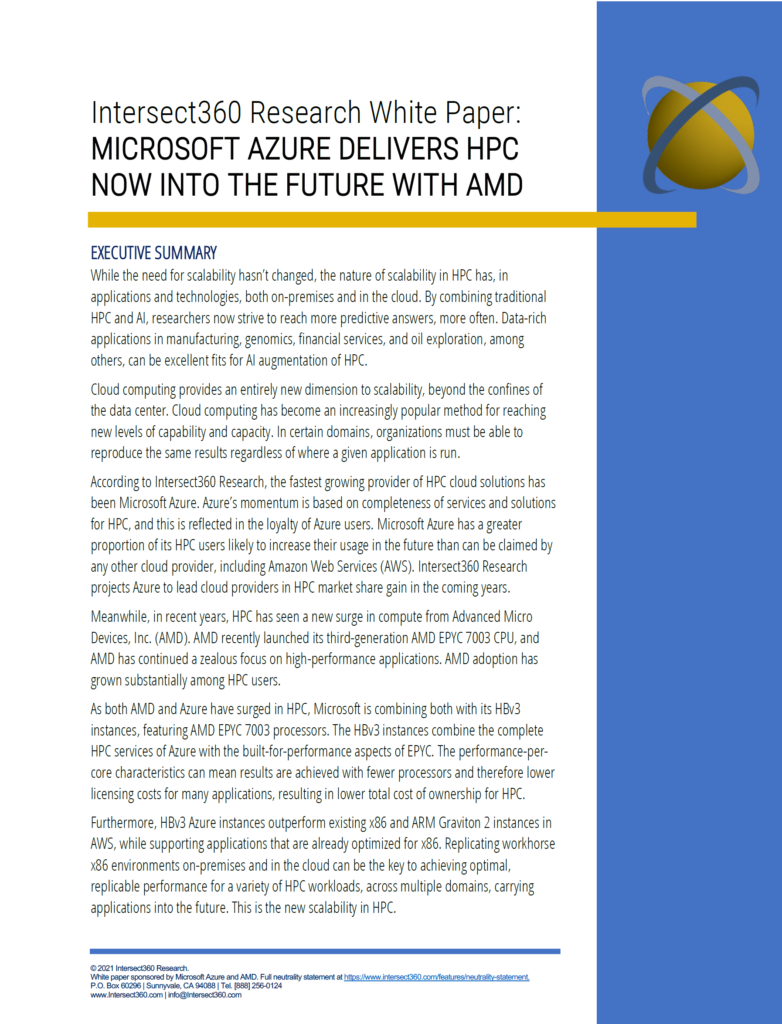This guest post from Intel explores how the global manufacturing industry is moving toward HPC adoption, and how it is approaching an inflection point which Intel refers to as “HPC for Everyone.”
 The global manufacturing industry is moving down the path to a fourth industrial revolution — Industry 4.0 — empowered by the opportunity to collect and analyze massive amounts of data, which will allow companies to more easily design products, improve them and bring them to market faster. For example, manufacturers today regularly use HPC for prototyping. Because HPC adoption allows them to perform a “run of one”, a manufacturer can quickly design a part using generative or additive design tools, and then 3D print a prototype. Doing so ensures all product elements function optimally before the high-volume manufacturing process gets underway.
The global manufacturing industry is moving down the path to a fourth industrial revolution — Industry 4.0 — empowered by the opportunity to collect and analyze massive amounts of data, which will allow companies to more easily design products, improve them and bring them to market faster. For example, manufacturers today regularly use HPC for prototyping. Because HPC adoption allows them to perform a “run of one”, a manufacturer can quickly design a part using generative or additive design tools, and then 3D print a prototype. Doing so ensures all product elements function optimally before the high-volume manufacturing process gets underway.
With the democratization of HPC, the manufacturing industry is approaching an inflection point which Intel refers to as “HPC for Everyone.” The cost-effectiveness and accessibility of HPC systems and services drive broadening adoption for manufacturers of all sizes.
At a recent design and manufacturing show, attendees representing companies of all sizes filled the halls. As evidenced by the heavy attendance at sessions focused on HPC in the Cloud, IoT, and computing at the edge, manufacturers demonstrated great enthusiasm for embracing these technological advancements. The scope of HPC implementation among attendees varied widely, though. While some have major HPC deployments in place, others are just starting to introduce HPC systems into their IT environments. Many companies’ systems reside somewhere in between those extremes, supporting engineering simulation, modeling, and 3D design workload capabilities with applications such as Ansys Mechanical*, FLUENT*, LS-DYNA* and other open source software.
HPC implementation is a step-by-step, iterative process. For most manufacturers, the substantial value from HPC derives from the collection of raw data generated by IoT-enabled tools and other critical systems. HPC-driven big data analysis can use that data to determine what role the data will play in your manufacturing workflow and ensure that the data is accurate and up to date. This constant collection and analysis of data allows the system to automatically make real-time adjustments to tools at any point along the line. Each manufacturer has unique needs from HPC-enabled systems, and the scale of implementation can vary widely with the scope and complexity of products.
Companies implementing HPC should prepare to work with very large data sets. For example, one of Intel’s customers processes 25,000 data points per second to predict and improve the reliability of their manufacturing flow. Another enterprise, which has deployed a substantial inventory of distributed devices, is processing 450M data points per second. Intel is also helping to automate a factory by collecting over five billion data points a day for analysis and decision making.
Companies implementing HPC should prepare to work with very large data sets.
In an application involving automotive crash testing, we are examining 10M data points per modeling run. In this case, scaling our HPC clusters up to 64 nodes provides optimal performance to run the data to meet the customer’s needs.
Another project – the development of the world’s first autonomous shipping platform – will use HPC to process the volumes of data continuously generated by devices sensing weather conditions, tide levels, wave points, visual data and the condition of a variety of onboard systems.
While many organizations today have an extensive HPC implementation tailored to their needs, others starting out with HPC adoption seek a simplified solution. For smaller-scale needs, working with an “HPC in the Cloud” provider like Amazon Web Services, Microsoft Azure, or Rescale can provide an effective option.
Alternately, for companies seeking a more turnkey on-premise HPC solution, Intel® Select Solutions offer a way for manufacturers to purchase pre-configured, pre-validated, workload optimized systems offered through OEMs, system providers, and ISV partners. Intel® Select Solutions for Simulation and Modeling and Intel® Select Solutions for Professional Visualization are tailored for their respective mission-critical workloads and accelerated deployment to jumpstart a manufacturer’s HPC implementation.
Intel and its partners remain dedicated to bringing HPC to those manufacturers who have yet to experience the advantages of HPC-driven solutions in their design and production processes. HPC for everyone – in manufacturing – is on its way.
Learn more about Intel Select Solutions.
Intel technologies’ features and benefits depend on system configuration and may require enabled hardware, software or service activation. Performance varies depending on system configuration. No computer system can be absolutely secure. Check with your system manufacturer or retailer or learn more here.
Intel and the Intel logo are trademarks of Intel Corporation or its subsidiaries in the U.S. and/or other countries.
*Other names and brands may be claimed as the property of others.




